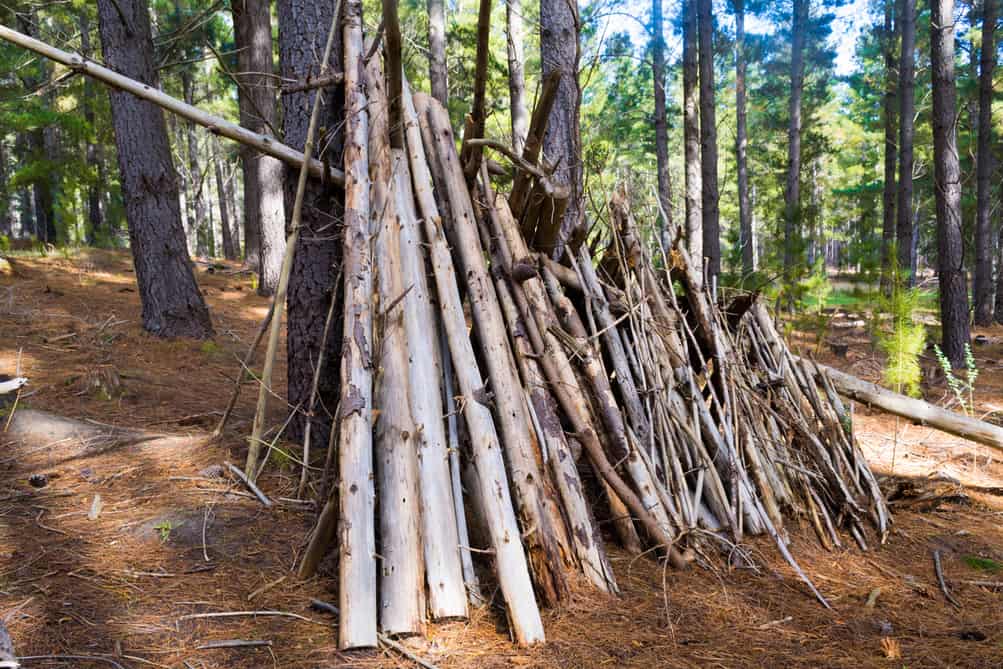Few skills are as crucial in outdoor survival as the ability to construct a temporary shelter. Whether you’re an avid backpacker, a wilderness enthusiast, or simply someone who wants to be prepared for unexpected situations, understanding how to build a shelter can mean the difference between comfort and peril in the great outdoors.
In this article, we give an introductory overview of emergency shelters.
Understanding Shelter Priorities
When faced with the need to build a temporary shelter, assessing the immediate environmental threats is essential. Consider factors such as weather conditions, terrain, and potential wildlife encounters. A well-constructed shelter should protect you from rain, wind, and extreme temperatures while also providing a barrier against insects and animals.
Balancing immediate needs with long-term sustainability is key. While a quick lean-to might suffice for a single night, a more robust structure may be necessary for extended stays. When planning your shelter, always prioritize protection from the elements and energy conservation.
Essential Tools and Materials
While having a basic survival kit with you is ideal, nature often provides the necessary materials for shelter construction. However, carrying a few essential items can significantly enhance your shelter-building capabilities:
- A sturdy knife or multi-tool.
- Paracord or strong rope.
- A lightweight tarp or emergency blanket.
- A small folding saw.
When scavenging for natural resources, look for:
- Sturdy branches for a framework.
- Leafy boughs for roofing and insulation.
- Dry grasses and moss for bedding.
- Stones for anchoring or creating windbreaks.
Remember, the ability to make fire with sticks can be a valuable skill to complement your shelter-building efforts, providing warmth and protection.
Choosing the Right Location
Selecting an appropriate site for your shelter is crucial. Look for:
- High ground to avoid water accumulation.
- Natural windbreaks like large rocks or dense vegetation.
- Proximity to water sources, but not too close to attract wildlife.
- Clear overhead to prevent falling branches or debris.
Avoid areas with dead-standing trees, flash flood risks, or signs of animal activity. A good location can significantly reduce the effort needed to build and maintain your shelter.
Basic Shelter Types
Quick and Simple Shelters
For immediate protection, consider:
- Tarp shelters: Versatile and quick to set up, tarp shelters like the A-frame or lean-to can provide instant protection from rain and wind.
- Natural shelters: Utilize existing features like cave openings or dense tree canopies for ready-made shelter.
Intermediate Shelters
As you develop your skills, try building:
- Debris huts: These cozy, insulated shelters are excellent for cold weather survival.
- Lean-to with natural materials: An upgrade from the tarp version, using branches and foliage for better insulation.
Advanced Shelters
For longer-term stays or group situations, consider:
- Round lodge: A tipi-like structure that offers excellent protection and space.
- Long-term wilderness shelters: More permanent structures that can withstand extended use and varying weather conditions.
Shelter-Building Techniques
Mastering a few fundamental techniques can significantly improve your shelter’s effectiveness:
- Learn essential knots like the taut-line hitch and bowline for secure construction.
- Waterproof your shelter by layering materials and creating proper slopes for water runoff.
- Insulate effectively using natural materials like leaves, pine needles, and moss.
Adapting Shelters for Different Environments
Different environments require unique approaches to shelter building:
- Desert shelters focus on shade and ventilation to combat extreme heat.
- Tropical rainforest shelters need excellent waterproofing and elevation to avoid ground moisture.
- Arctic shelters like snow caves provide insulation from extreme cold.
- Mountain shelters must withstand high winds and rapid weather changes.
Understanding these variations is crucial when navigating the wilderness in diverse landscapes.
Maximizing Shelter Efficiency
To enhance your shelter’s comfort and functionality:
- Create a raised sleeping platform to insulate yourself from the cold ground.
- Ensure proper ventilation to prevent condensation and maintain air quality.
- If using a fire, position it carefully for warmth without compromising safety.
Emergency Shelter Scenarios
In dire situations, you may need to construct a shelter quickly with minimal resources. Practice building shelters using only what you can find in nature, and learn to adapt everyday items like garbage bags or vehicle parts for emergency protection.
Shelter Maintenance and Improvements
For prolonged stays, regular maintenance is crucial:
- Reinforce your shelter daily, checking for weak points or weather damage.
- Gradually improve your shelter by adding features like storage areas or expanded living space.
Safety Considerations
Always prioritize safety when building and using temporary shelters:
- Be aware of potential hazards like falling branches or unstable structures.
- Take precautions against wildlife, such as proper food storage and maintaining a clean camp.
Practicing Shelter-Building Skills
The key to mastering shelter building is practice. Start with backyard exercises to hone your skills, then incorporate shelter building into your outdoor trips. This hands-on experience is invaluable for developing confidence and efficiency in real-world situations.
For those interested in enhancing their overall outdoor preparedness, consider learning about off-grid camping essentials and off-grid communication for campers. These skills complement shelter building and contribute to a comprehensive outdoor survival skill set.
Conclusion
Mastering the art of temporary shelter building is an essential skill for anyone venturing into the wilderness. By understanding the principles of shelter construction, adapting to varioqus environments, and continuously practicing your skills, you’ll be well-prepared to face outdoor challenges confidently. Remember, the ability to create a safe haven in the wild not only ensures your survival but also enhances your overall outdoor experience.

Leave a Reply